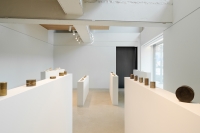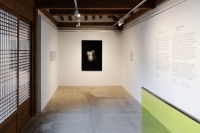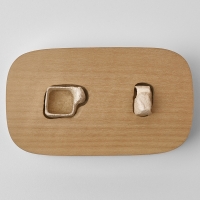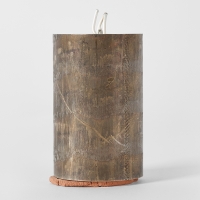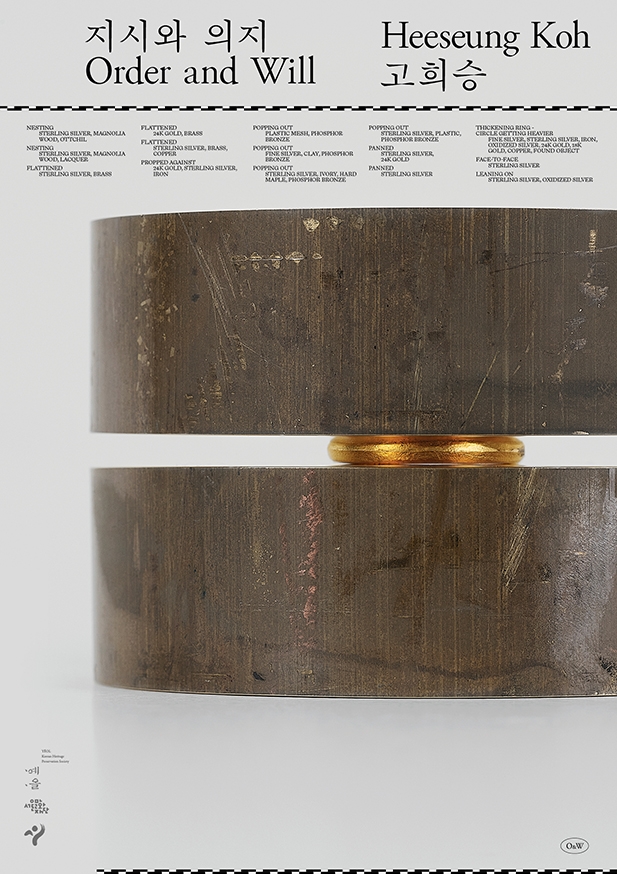
고희승 개인전 Heeseung Koh Solo-Exhibition
지시와 의지_Order and Will
2021. 12. 15(수 wed.) – 12. 28 (화 tues.)
예올 북촌가
서울특별시 종로구 북촌로 50-1 우)03056
YÉOL Bukchon-ga
50-1 Bukchonro, Jongno-gu, Seoul 03056 Korea
기획 김그린
사진 김주영, 손미현
후원 서울시, 서울문화재단
사물의 형태와 기능은 오랜 시간에 걸쳐 형성된 공동의 약속이다. 창작은 다수가 동의한 결과에 어긋남을 만드는 일로 창작자는 사물의 형식을 해체하고 조합하여 그에 대한 새로운 정의를 제시한다. 낯선 사물을 맞이한 수용자는 그간 학습해 온 사고의 흐름을 따라 사물의 형태와 사용법을 익혀 나간다. 그리고 어느 정도 손에 익으면 자신만의 방식으로 사물을 길들인다. 그 과정에서 길들여진 것은 일반적인 사물로 받아들여지고 그렇지 못한 것은 도태되지만, 총체적으로 보면 합리적 사고에 틈을 내는 낯선 사물을 마주하는 경험은 보편성에 대한 인식의 지평을 넓히는 데에 기여한다.
장신구 작가 고희승은 도시 풍경에서 흔적과 관련된 이미지를 채집하고, 그에 대한 관찰을 브로치, 목걸이, 반지 등의 장신구로 표현한다. 장신구는 몸을 장식하는 데 사용하는 도구로 신체라는 엄격하고 예민한 틀을 고려하여 크기, 무게, 형태가 결정된다. 따라서 장신구 작가에게 있어 창작은 장신구로 역할 할 수 있는 경계선을 인지하고 그 범위를 넓혀가는 것이다. 지난 30년간 장신구 작업을 해 온 고희승은 특히 다수의 반지 시리즈를 제작해왔다. 그는 반지로 기능할 수 있는 가장 기본의 조건인 손가락 크기의 구멍을 기준으로 하여 다양한 조형적 실험을 펼치며, 재료의 물성과 질감을 드러내는 제작 방식을 숙련해왔다. 특히 반지를 제작하는 과정에서 생긴 흔적을 다듬지 않고 그대로 나타내고, 그 위에 착용자가 새로운 흔적을 더해 나가는 모습은 고희승의 반지가 가진 특징이다. ‘흔적’에 대한 그의 바람은 반지가 착용되지 않았을 때의 상태에 대한 상상으로 확장하여, 반지를 보관하는 반지함 시리즈를 구상하기에 이른다. 반지는 그 특유의 조형으로 인해 보여지는 방식, 착용되는 방식, 보관되는 방식이 일률적인 편으로, 일반적으로 반지의 ‘윗면’으로 인식되는 부분, 즉 착용했을 때에 손가락의 윗면에 놓여 조형적 표현을 담당하는 부분을 숨기거나 드러내어 보호하는 방식으로 보관되어 진다. 고희승은 ‘숨기다’, ‘드러내다’라는 개념에서 출발하여, 반지와 반지가 아닌 사물을 비교하며 그동안 만들어 온 반지에 알맞은 자리를 찾아간다. 그가 만든 반지함에서 반지는 수동적인 무용의 상태로 보호받기보다, 무언가를 받치거나, 힘을 가하거나, 메우며 하나의 장면을 완성하기 위해 반드시 필요한 구성원으로서 역할이 주어진다. 반면 반지함은 나무 덩어리, 파이프, 얇은 판재 등 도시에서 채집한 듯한 재료로 만들어지고, 반지를 분리하면 순수한 재료 덩어리로 돌아가 도시의 풍경 속으로 흡수된다.
반지함 시리즈를 만드는 과정에서 고희승은 기존의 반지 작업과는 전혀 다른 그물망처럼 생기거나 끈처럼 생겨 착용자가 직접 구멍을 만들어서 착용하는 형식의 반지를 제작한다. 새로운 반지는 구멍에 대한 정의를 확장하고 착용자의 적극적인 참여를 도모한다. 반지의 자리에 대한 생각에서 시작하여 다시 반지로 돌아오기까지, 이러한 일련의 과정은 작가에게 자신의 작업을 돌아보는 계기가 된다. 그리고 그 안에서, 어쩌면 무심코 행해온 반복적인 손의 움직임을 다시 학습하며 나아갈 방향을 탐색하는 창작자의 모습을 발견한다.
글. 김그린
An object’s shape and function are a mutual promise that is formed over a long period of time. Creation is the act of making “dislocations” in an outcome that received approval by the majority: this makes the creator someone who disassembles an object to reassemble and proposes a new definition. The user, faced with a foreign object, familiarizes oneself with the object’s new shape as well as its function based on their foundational knowledge of object. Once the object is familiarized, it is molded to the user’s purposes. Things that become familiar are accepted into our daily lives as “normal” objects, while those that fail to become familiar are phased out. This process of encountering strange objects helps broaden our conception of universality.
Jewelry artist Heeseung Koh collects images of the urban landscape and applies her observations of them to brooches, necklaces, and rings. The highly-sensitive and strict backdrop that is the human body defines the size, weight, and shape of the jewelry. For a jewelry artist, creation is the act of ascertaining the boundaries of the ornament’s role and then broadening boundaries. Koh, who has worked on jewelry for 30 years, is especially known for her ring series. She has spent much of her career experimenting with diverse structural aspects of the finger hole, the most fundamental aspect of the ring, and revealing the texture of materials. In particular, Koh’s rings are characterized by the traces from the making process and how it is enhanced over time by accumulating traces from wearing them.
Koh’s affection for traces led her to imagine the ring when it is not worn and, eventually, making the ring cases. The ring, given its characteristic shape, is shown, worn, and stored in mostly the same ways. In general, the “top” of the ring—the part visible on the finger when worn—is either displayed to emphasize its aesthetic quality or hidden for protection. Koh started with this display/protection concept, comparing rings with other anonymous objects, and searching for the right place for each ring. In Koh’s ring case, the ring is not a passive, functionless entity that needs protection but a necessary element that supports, presses, or completes other elements. The ring case, on the other hand, is made out of materials collected from the urban landscape (e.g. blocks of wood, pipes, thin metal plates). Once the ring is removed, the case is reabsorbed into the cityscape as a chunk of natural material.
In making the ring cases, Koh produces new rings shaped like a fishing net or rope with which the user makes the hole on their own to wear the rings. This new ring expands the definition of the "hole" in rings and allows the user to be an active participant in the act of creation. While working on the new series, Koh looks back on her past works and finds herself, the creator, exploring the direction of moving forward by re-learning the repetitive movements of hands.
기대다 leaning onᅠ 정은 sterling silver, oxidized silverᅠ 20×20×20mmᅠ 2021
머무르다 nestingᅠ 정은, 목련나무, 옻칠 sterling silver, magnolia wood, ottchilᅠ 120×70×60mmᅠ 2021
내밀다 popping outᅠ 순은, 점토, 인청동 fine silver, clay, phosphor bronzeᅠ ∅43×85mmᅠ 2021
